Comprehensive Accounting Analysis: JB Hi-Fi & Country Road Limited
VerifiedAdded on 2020/05/03
|10
|2278
|322
Report
AI Summary
This report provides a comprehensive accounting analysis of the financial statements of JB Hi-Fi Limited and Country Road Limited. Part A focuses on JB Hi-Fi, examining the increase in current liabilities, major liabilities, components of provisions, interest-bearing loans, secured non-current liabilities, and non-current provisions. Part B shifts to Country Road Limited, comparing accounting practices between a company and a partnership firm, including income tax expense, retained earnings, issued capital, and the preparation of a cash flow statement. The analysis covers key financial aspects such as liabilities, equity, and cash flow, offering insights into the financial performance and structure of both companies while contrasting them with partnership accounting principles. The report also references relevant accounting standards like IAS 37/AASB137.
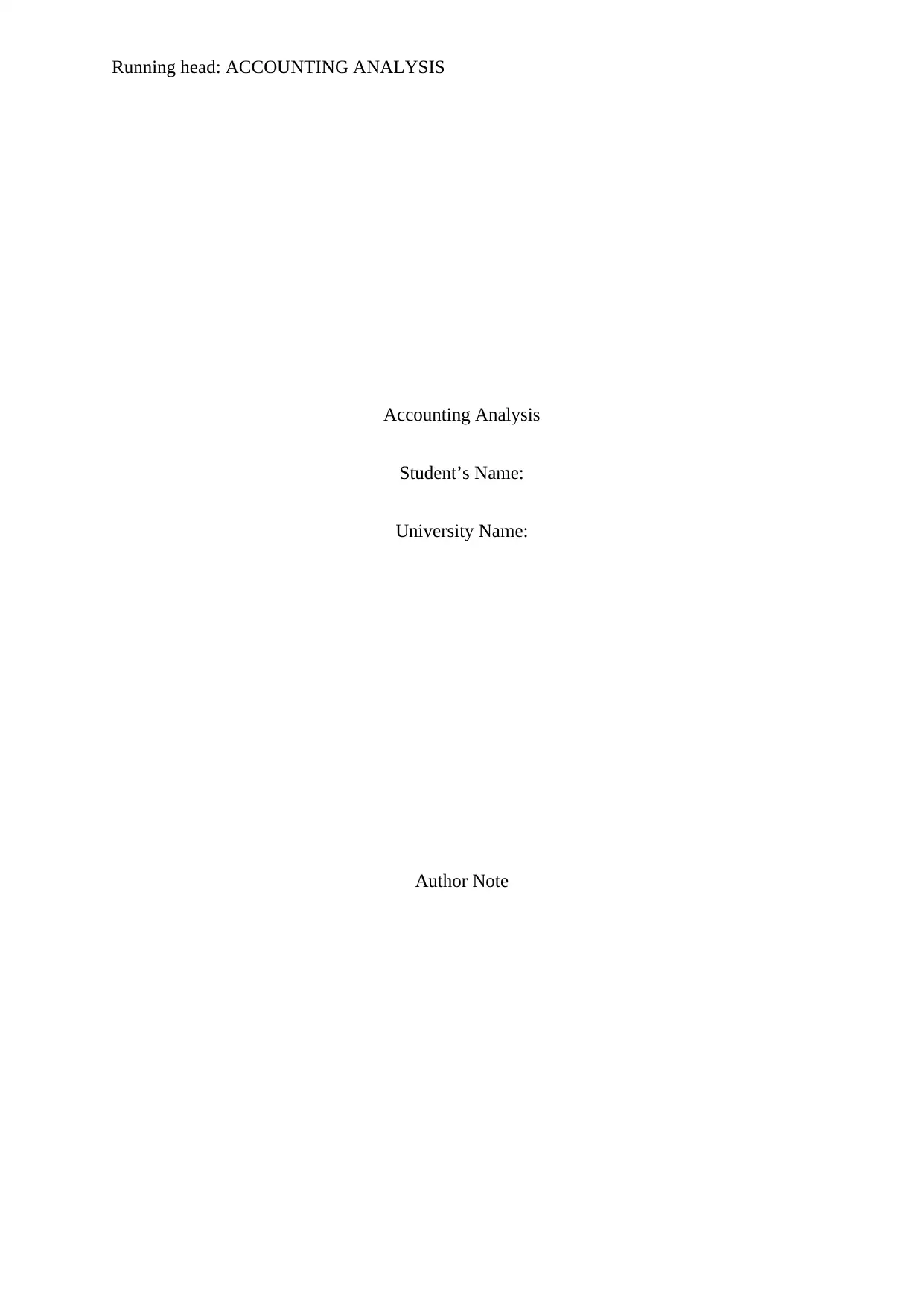
Running head: ACCOUNTING ANALYSIS
Accounting Analysis
Student’s Name:
University Name:
Author Note
Accounting Analysis
Student’s Name:
University Name:
Author Note
Paraphrase This Document
Need a fresh take? Get an instant paraphrase of this document with our AI Paraphraser
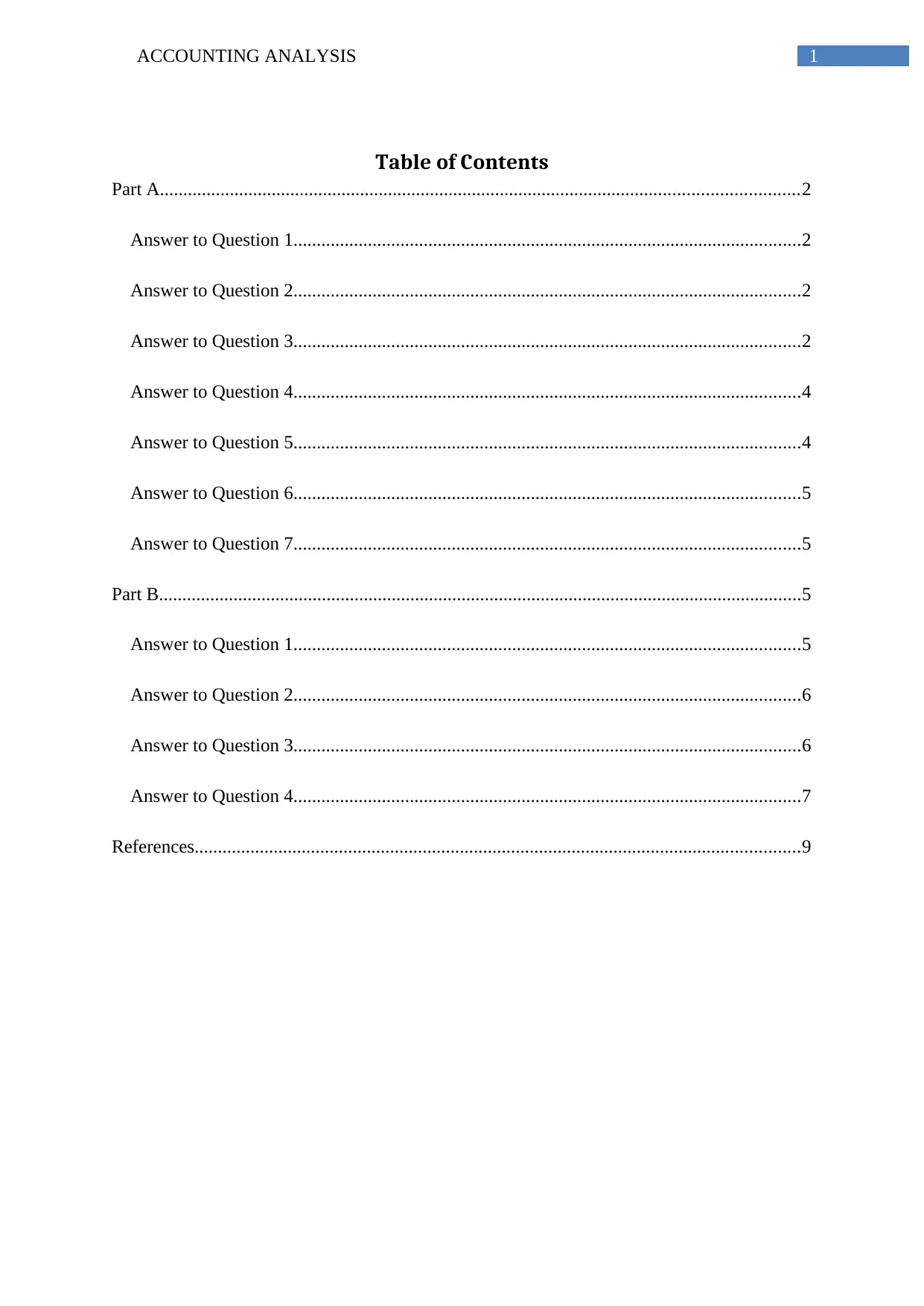
1ACCOUNTING ANALYSIS
Table of Contents
Part A.........................................................................................................................................2
Answer to Question 1.............................................................................................................2
Answer to Question 2.............................................................................................................2
Answer to Question 3.............................................................................................................2
Answer to Question 4.............................................................................................................4
Answer to Question 5.............................................................................................................4
Answer to Question 6.............................................................................................................5
Answer to Question 7.............................................................................................................5
Part B..........................................................................................................................................5
Answer to Question 1.............................................................................................................5
Answer to Question 2.............................................................................................................6
Answer to Question 3.............................................................................................................6
Answer to Question 4.............................................................................................................7
References..................................................................................................................................9
Table of Contents
Part A.........................................................................................................................................2
Answer to Question 1.............................................................................................................2
Answer to Question 2.............................................................................................................2
Answer to Question 3.............................................................................................................2
Answer to Question 4.............................................................................................................4
Answer to Question 5.............................................................................................................4
Answer to Question 6.............................................................................................................5
Answer to Question 7.............................................................................................................5
Part B..........................................................................................................................................5
Answer to Question 1.............................................................................................................5
Answer to Question 2.............................................................................................................6
Answer to Question 3.............................................................................................................6
Answer to Question 4.............................................................................................................7
References..................................................................................................................................9
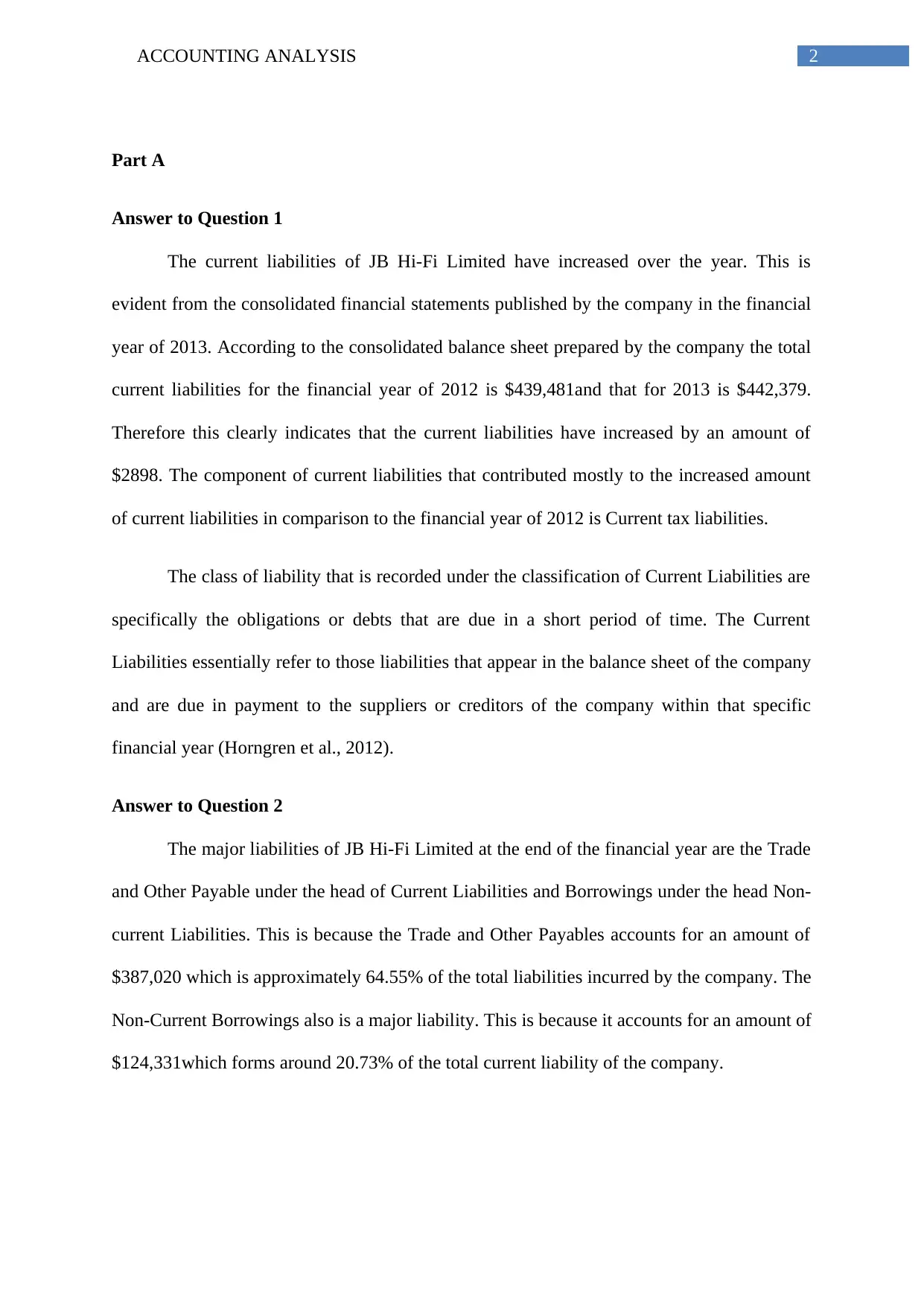
2ACCOUNTING ANALYSIS
Part A
Answer to Question 1
The current liabilities of JB Hi-Fi Limited have increased over the year. This is
evident from the consolidated financial statements published by the company in the financial
year of 2013. According to the consolidated balance sheet prepared by the company the total
current liabilities for the financial year of 2012 is $439,481and that for 2013 is $442,379.
Therefore this clearly indicates that the current liabilities have increased by an amount of
$2898. The component of current liabilities that contributed mostly to the increased amount
of current liabilities in comparison to the financial year of 2012 is Current tax liabilities.
The class of liability that is recorded under the classification of Current Liabilities are
specifically the obligations or debts that are due in a short period of time. The Current
Liabilities essentially refer to those liabilities that appear in the balance sheet of the company
and are due in payment to the suppliers or creditors of the company within that specific
financial year (Horngren et al., 2012).
Answer to Question 2
The major liabilities of JB Hi-Fi Limited at the end of the financial year are the Trade
and Other Payable under the head of Current Liabilities and Borrowings under the head Non-
current Liabilities. This is because the Trade and Other Payables accounts for an amount of
$387,020 which is approximately 64.55% of the total liabilities incurred by the company. The
Non-Current Borrowings also is a major liability. This is because it accounts for an amount of
$124,331which forms around 20.73% of the total current liability of the company.
Part A
Answer to Question 1
The current liabilities of JB Hi-Fi Limited have increased over the year. This is
evident from the consolidated financial statements published by the company in the financial
year of 2013. According to the consolidated balance sheet prepared by the company the total
current liabilities for the financial year of 2012 is $439,481and that for 2013 is $442,379.
Therefore this clearly indicates that the current liabilities have increased by an amount of
$2898. The component of current liabilities that contributed mostly to the increased amount
of current liabilities in comparison to the financial year of 2012 is Current tax liabilities.
The class of liability that is recorded under the classification of Current Liabilities are
specifically the obligations or debts that are due in a short period of time. The Current
Liabilities essentially refer to those liabilities that appear in the balance sheet of the company
and are due in payment to the suppliers or creditors of the company within that specific
financial year (Horngren et al., 2012).
Answer to Question 2
The major liabilities of JB Hi-Fi Limited at the end of the financial year are the Trade
and Other Payable under the head of Current Liabilities and Borrowings under the head Non-
current Liabilities. This is because the Trade and Other Payables accounts for an amount of
$387,020 which is approximately 64.55% of the total liabilities incurred by the company. The
Non-Current Borrowings also is a major liability. This is because it accounts for an amount of
$124,331which forms around 20.73% of the total current liability of the company.
⊘ This is a preview!⊘
Do you want full access?
Subscribe today to unlock all pages.

Trusted by 1+ million students worldwide
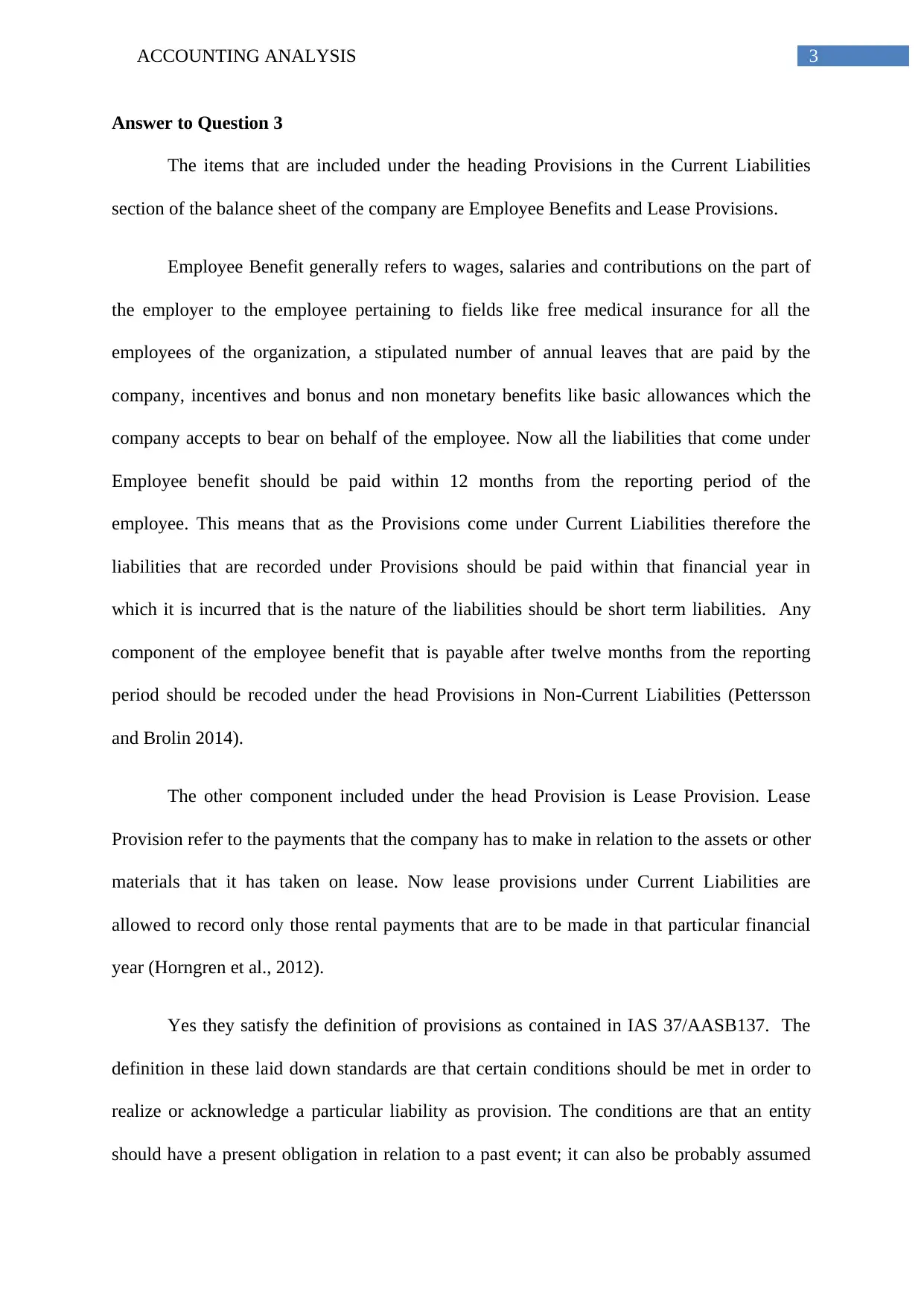
3ACCOUNTING ANALYSIS
Answer to Question 3
The items that are included under the heading Provisions in the Current Liabilities
section of the balance sheet of the company are Employee Benefits and Lease Provisions.
Employee Benefit generally refers to wages, salaries and contributions on the part of
the employer to the employee pertaining to fields like free medical insurance for all the
employees of the organization, a stipulated number of annual leaves that are paid by the
company, incentives and bonus and non monetary benefits like basic allowances which the
company accepts to bear on behalf of the employee. Now all the liabilities that come under
Employee benefit should be paid within 12 months from the reporting period of the
employee. This means that as the Provisions come under Current Liabilities therefore the
liabilities that are recorded under Provisions should be paid within that financial year in
which it is incurred that is the nature of the liabilities should be short term liabilities. Any
component of the employee benefit that is payable after twelve months from the reporting
period should be recoded under the head Provisions in Non-Current Liabilities (Pettersson
and Brolin 2014).
The other component included under the head Provision is Lease Provision. Lease
Provision refer to the payments that the company has to make in relation to the assets or other
materials that it has taken on lease. Now lease provisions under Current Liabilities are
allowed to record only those rental payments that are to be made in that particular financial
year (Horngren et al., 2012).
Yes they satisfy the definition of provisions as contained in IAS 37/AASB137. The
definition in these laid down standards are that certain conditions should be met in order to
realize or acknowledge a particular liability as provision. The conditions are that an entity
should have a present obligation in relation to a past event; it can also be probably assumed
Answer to Question 3
The items that are included under the heading Provisions in the Current Liabilities
section of the balance sheet of the company are Employee Benefits and Lease Provisions.
Employee Benefit generally refers to wages, salaries and contributions on the part of
the employer to the employee pertaining to fields like free medical insurance for all the
employees of the organization, a stipulated number of annual leaves that are paid by the
company, incentives and bonus and non monetary benefits like basic allowances which the
company accepts to bear on behalf of the employee. Now all the liabilities that come under
Employee benefit should be paid within 12 months from the reporting period of the
employee. This means that as the Provisions come under Current Liabilities therefore the
liabilities that are recorded under Provisions should be paid within that financial year in
which it is incurred that is the nature of the liabilities should be short term liabilities. Any
component of the employee benefit that is payable after twelve months from the reporting
period should be recoded under the head Provisions in Non-Current Liabilities (Pettersson
and Brolin 2014).
The other component included under the head Provision is Lease Provision. Lease
Provision refer to the payments that the company has to make in relation to the assets or other
materials that it has taken on lease. Now lease provisions under Current Liabilities are
allowed to record only those rental payments that are to be made in that particular financial
year (Horngren et al., 2012).
Yes they satisfy the definition of provisions as contained in IAS 37/AASB137. The
definition in these laid down standards are that certain conditions should be met in order to
realize or acknowledge a particular liability as provision. The conditions are that an entity
should have a present obligation in relation to a past event; it can also be probably assumed
Paraphrase This Document
Need a fresh take? Get an instant paraphrase of this document with our AI Paraphraser
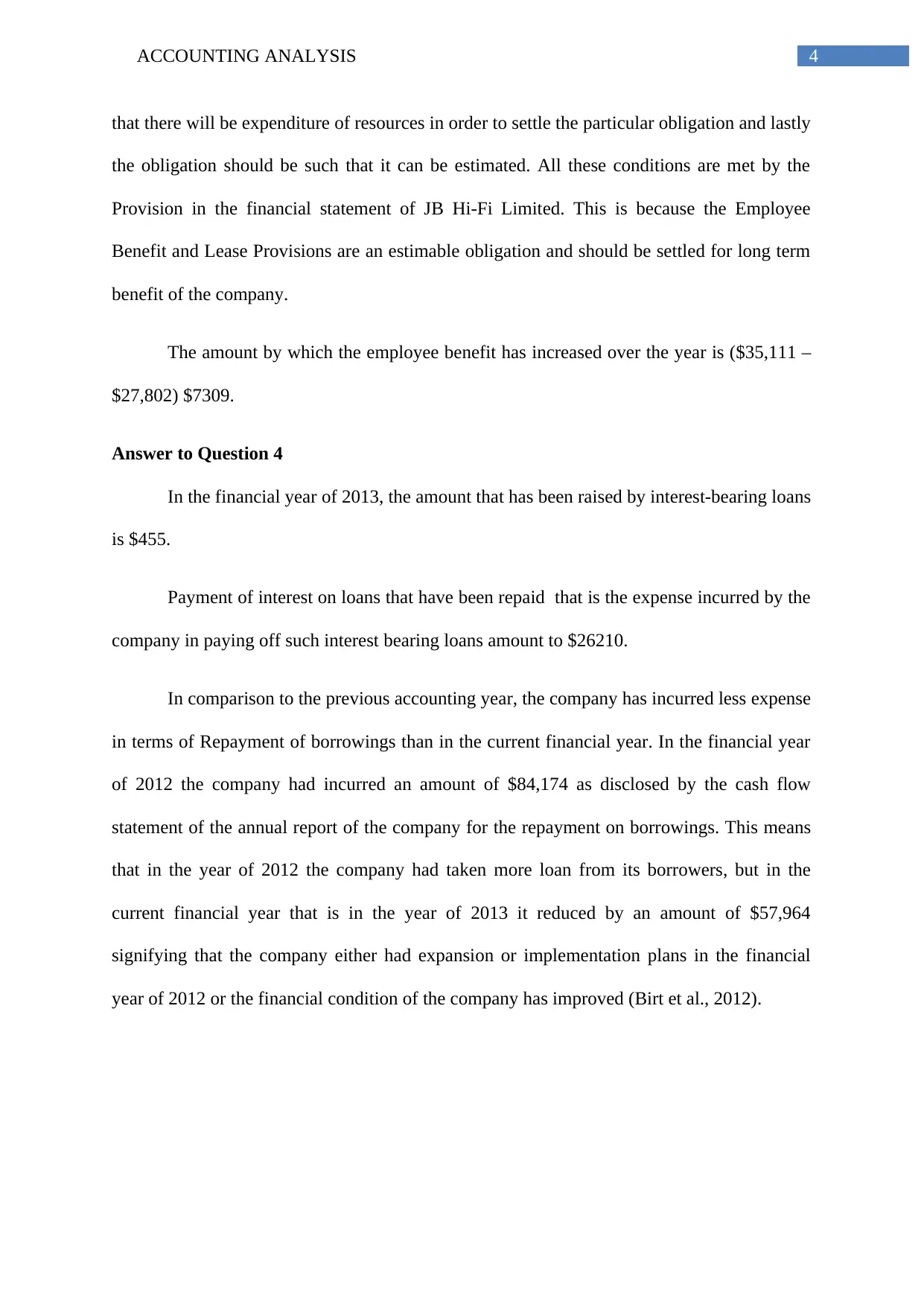
4ACCOUNTING ANALYSIS
that there will be expenditure of resources in order to settle the particular obligation and lastly
the obligation should be such that it can be estimated. All these conditions are met by the
Provision in the financial statement of JB Hi-Fi Limited. This is because the Employee
Benefit and Lease Provisions are an estimable obligation and should be settled for long term
benefit of the company.
The amount by which the employee benefit has increased over the year is ($35,111 –
$27,802) $7309.
Answer to Question 4
In the financial year of 2013, the amount that has been raised by interest-bearing loans
is $455.
Payment of interest on loans that have been repaid that is the expense incurred by the
company in paying off such interest bearing loans amount to $26210.
In comparison to the previous accounting year, the company has incurred less expense
in terms of Repayment of borrowings than in the current financial year. In the financial year
of 2012 the company had incurred an amount of $84,174 as disclosed by the cash flow
statement of the annual report of the company for the repayment on borrowings. This means
that in the year of 2012 the company had taken more loan from its borrowers, but in the
current financial year that is in the year of 2013 it reduced by an amount of $57,964
signifying that the company either had expansion or implementation plans in the financial
year of 2012 or the financial condition of the company has improved (Birt et al., 2012).
that there will be expenditure of resources in order to settle the particular obligation and lastly
the obligation should be such that it can be estimated. All these conditions are met by the
Provision in the financial statement of JB Hi-Fi Limited. This is because the Employee
Benefit and Lease Provisions are an estimable obligation and should be settled for long term
benefit of the company.
The amount by which the employee benefit has increased over the year is ($35,111 –
$27,802) $7309.
Answer to Question 4
In the financial year of 2013, the amount that has been raised by interest-bearing loans
is $455.
Payment of interest on loans that have been repaid that is the expense incurred by the
company in paying off such interest bearing loans amount to $26210.
In comparison to the previous accounting year, the company has incurred less expense
in terms of Repayment of borrowings than in the current financial year. In the financial year
of 2012 the company had incurred an amount of $84,174 as disclosed by the cash flow
statement of the annual report of the company for the repayment on borrowings. This means
that in the year of 2012 the company had taken more loan from its borrowers, but in the
current financial year that is in the year of 2013 it reduced by an amount of $57,964
signifying that the company either had expansion or implementation plans in the financial
year of 2012 or the financial condition of the company has improved (Birt et al., 2012).
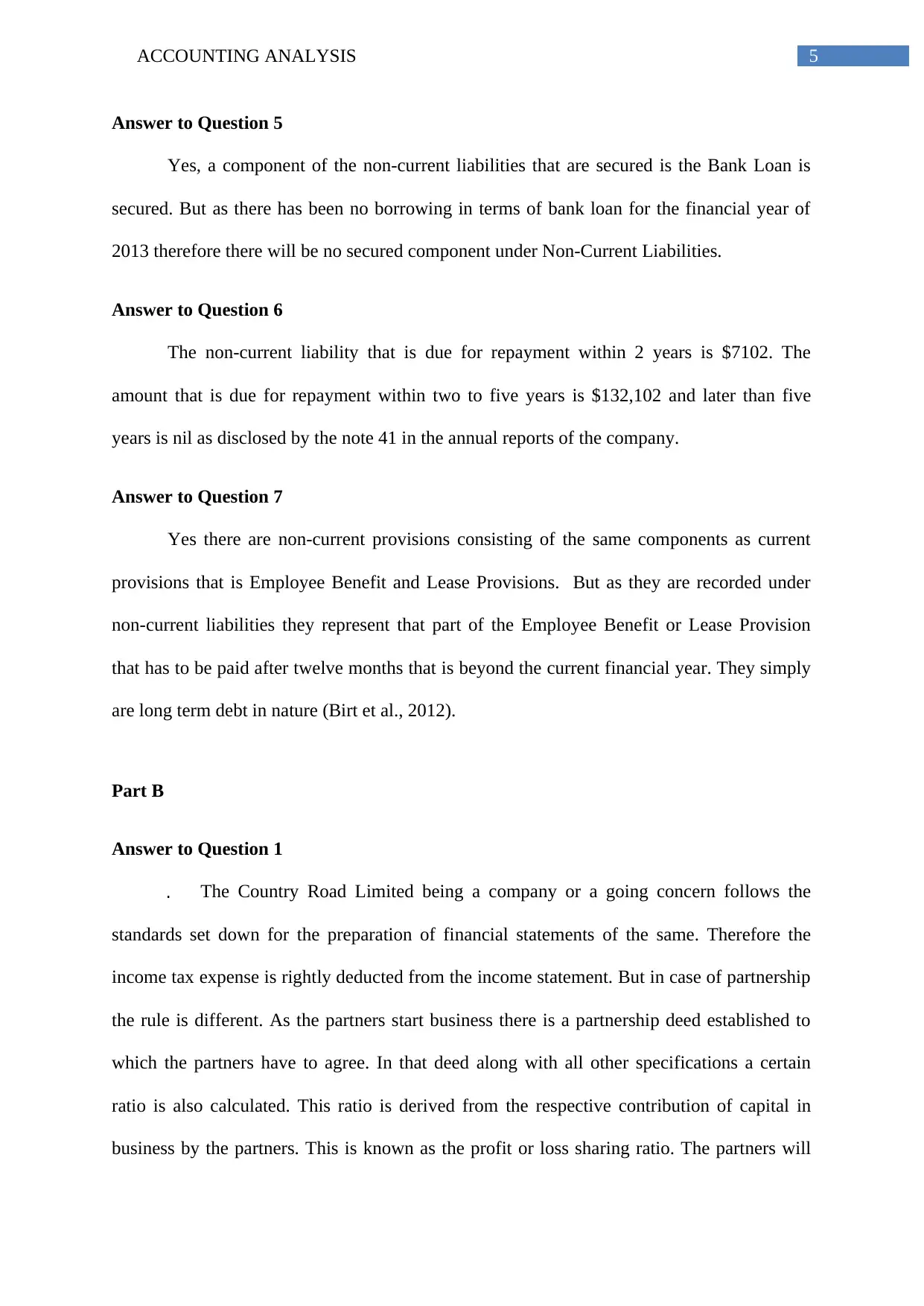
5ACCOUNTING ANALYSIS
Answer to Question 5
Yes, a component of the non-current liabilities that are secured is the Bank Loan is
secured. But as there has been no borrowing in terms of bank loan for the financial year of
2013 therefore there will be no secured component under Non-Current Liabilities.
Answer to Question 6
The non-current liability that is due for repayment within 2 years is $7102. The
amount that is due for repayment within two to five years is $132,102 and later than five
years is nil as disclosed by the note 41 in the annual reports of the company.
Answer to Question 7
Yes there are non-current provisions consisting of the same components as current
provisions that is Employee Benefit and Lease Provisions. But as they are recorded under
non-current liabilities they represent that part of the Employee Benefit or Lease Provision
that has to be paid after twelve months that is beyond the current financial year. They simply
are long term debt in nature (Birt et al., 2012).
Part B
Answer to Question 1
The Country Road Limited being a company or a going concern follows the
standards set down for the preparation of financial statements of the same. Therefore the
income tax expense is rightly deducted from the income statement. But in case of partnership
the rule is different. As the partners start business there is a partnership deed established to
which the partners have to agree. In that deed along with all other specifications a certain
ratio is also calculated. This ratio is derived from the respective contribution of capital in
business by the partners. This is known as the profit or loss sharing ratio. The partners will
Answer to Question 5
Yes, a component of the non-current liabilities that are secured is the Bank Loan is
secured. But as there has been no borrowing in terms of bank loan for the financial year of
2013 therefore there will be no secured component under Non-Current Liabilities.
Answer to Question 6
The non-current liability that is due for repayment within 2 years is $7102. The
amount that is due for repayment within two to five years is $132,102 and later than five
years is nil as disclosed by the note 41 in the annual reports of the company.
Answer to Question 7
Yes there are non-current provisions consisting of the same components as current
provisions that is Employee Benefit and Lease Provisions. But as they are recorded under
non-current liabilities they represent that part of the Employee Benefit or Lease Provision
that has to be paid after twelve months that is beyond the current financial year. They simply
are long term debt in nature (Birt et al., 2012).
Part B
Answer to Question 1
The Country Road Limited being a company or a going concern follows the
standards set down for the preparation of financial statements of the same. Therefore the
income tax expense is rightly deducted from the income statement. But in case of partnership
the rule is different. As the partners start business there is a partnership deed established to
which the partners have to agree. In that deed along with all other specifications a certain
ratio is also calculated. This ratio is derived from the respective contribution of capital in
business by the partners. This is known as the profit or loss sharing ratio. The partners will
⊘ This is a preview!⊘
Do you want full access?
Subscribe today to unlock all pages.

Trusted by 1+ million students worldwide
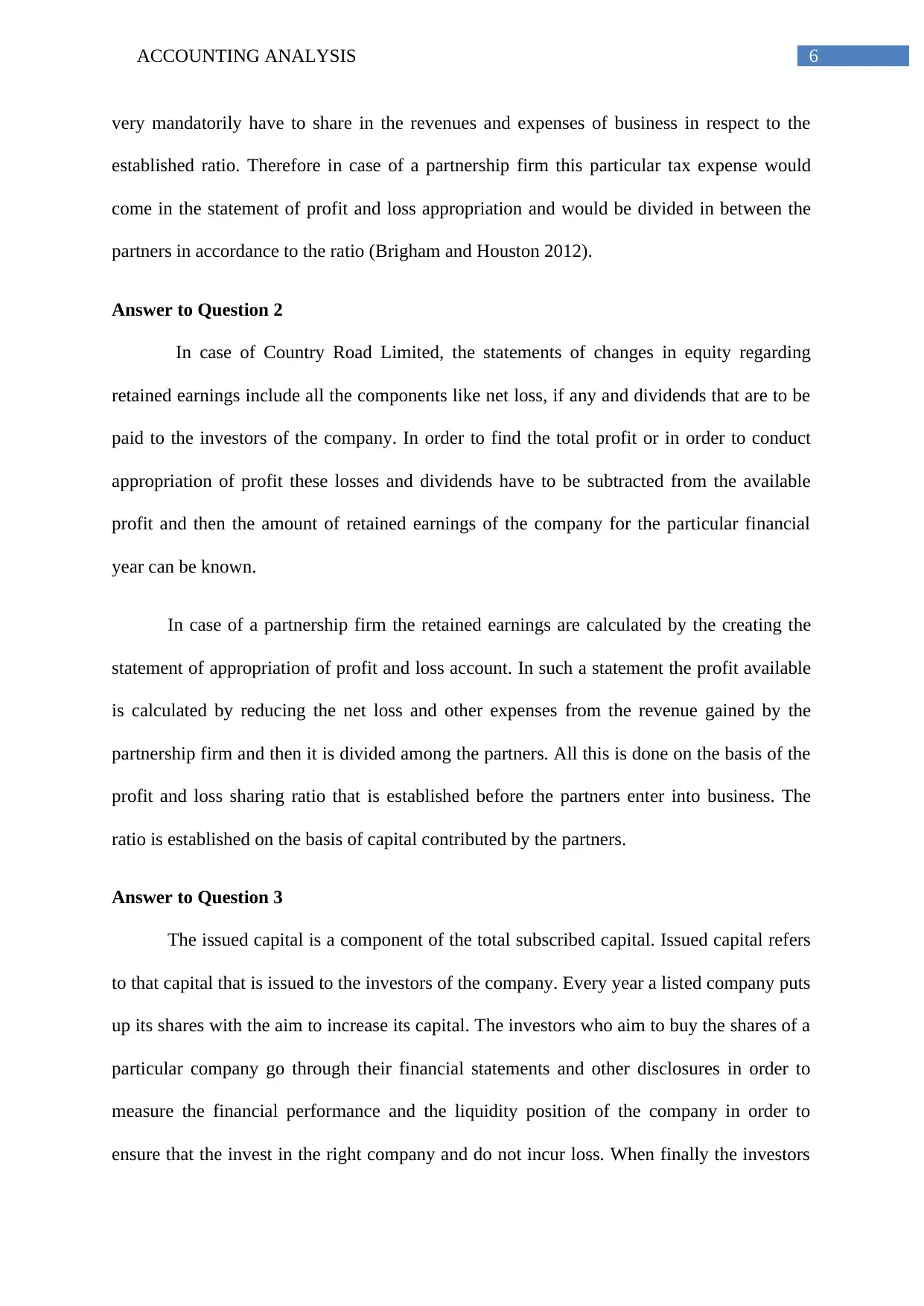
6ACCOUNTING ANALYSIS
very mandatorily have to share in the revenues and expenses of business in respect to the
established ratio. Therefore in case of a partnership firm this particular tax expense would
come in the statement of profit and loss appropriation and would be divided in between the
partners in accordance to the ratio (Brigham and Houston 2012).
Answer to Question 2
In case of Country Road Limited, the statements of changes in equity regarding
retained earnings include all the components like net loss, if any and dividends that are to be
paid to the investors of the company. In order to find the total profit or in order to conduct
appropriation of profit these losses and dividends have to be subtracted from the available
profit and then the amount of retained earnings of the company for the particular financial
year can be known.
In case of a partnership firm the retained earnings are calculated by the creating the
statement of appropriation of profit and loss account. In such a statement the profit available
is calculated by reducing the net loss and other expenses from the revenue gained by the
partnership firm and then it is divided among the partners. All this is done on the basis of the
profit and loss sharing ratio that is established before the partners enter into business. The
ratio is established on the basis of capital contributed by the partners.
Answer to Question 3
The issued capital is a component of the total subscribed capital. Issued capital refers
to that capital that is issued to the investors of the company. Every year a listed company puts
up its shares with the aim to increase its capital. The investors who aim to buy the shares of a
particular company go through their financial statements and other disclosures in order to
measure the financial performance and the liquidity position of the company in order to
ensure that the invest in the right company and do not incur loss. When finally the investors
very mandatorily have to share in the revenues and expenses of business in respect to the
established ratio. Therefore in case of a partnership firm this particular tax expense would
come in the statement of profit and loss appropriation and would be divided in between the
partners in accordance to the ratio (Brigham and Houston 2012).
Answer to Question 2
In case of Country Road Limited, the statements of changes in equity regarding
retained earnings include all the components like net loss, if any and dividends that are to be
paid to the investors of the company. In order to find the total profit or in order to conduct
appropriation of profit these losses and dividends have to be subtracted from the available
profit and then the amount of retained earnings of the company for the particular financial
year can be known.
In case of a partnership firm the retained earnings are calculated by the creating the
statement of appropriation of profit and loss account. In such a statement the profit available
is calculated by reducing the net loss and other expenses from the revenue gained by the
partnership firm and then it is divided among the partners. All this is done on the basis of the
profit and loss sharing ratio that is established before the partners enter into business. The
ratio is established on the basis of capital contributed by the partners.
Answer to Question 3
The issued capital is a component of the total subscribed capital. Issued capital refers
to that capital that is issued to the investors of the company. Every year a listed company puts
up its shares with the aim to increase its capital. The investors who aim to buy the shares of a
particular company go through their financial statements and other disclosures in order to
measure the financial performance and the liquidity position of the company in order to
ensure that the invest in the right company and do not incur loss. When finally the investors
Paraphrase This Document
Need a fresh take? Get an instant paraphrase of this document with our AI Paraphraser
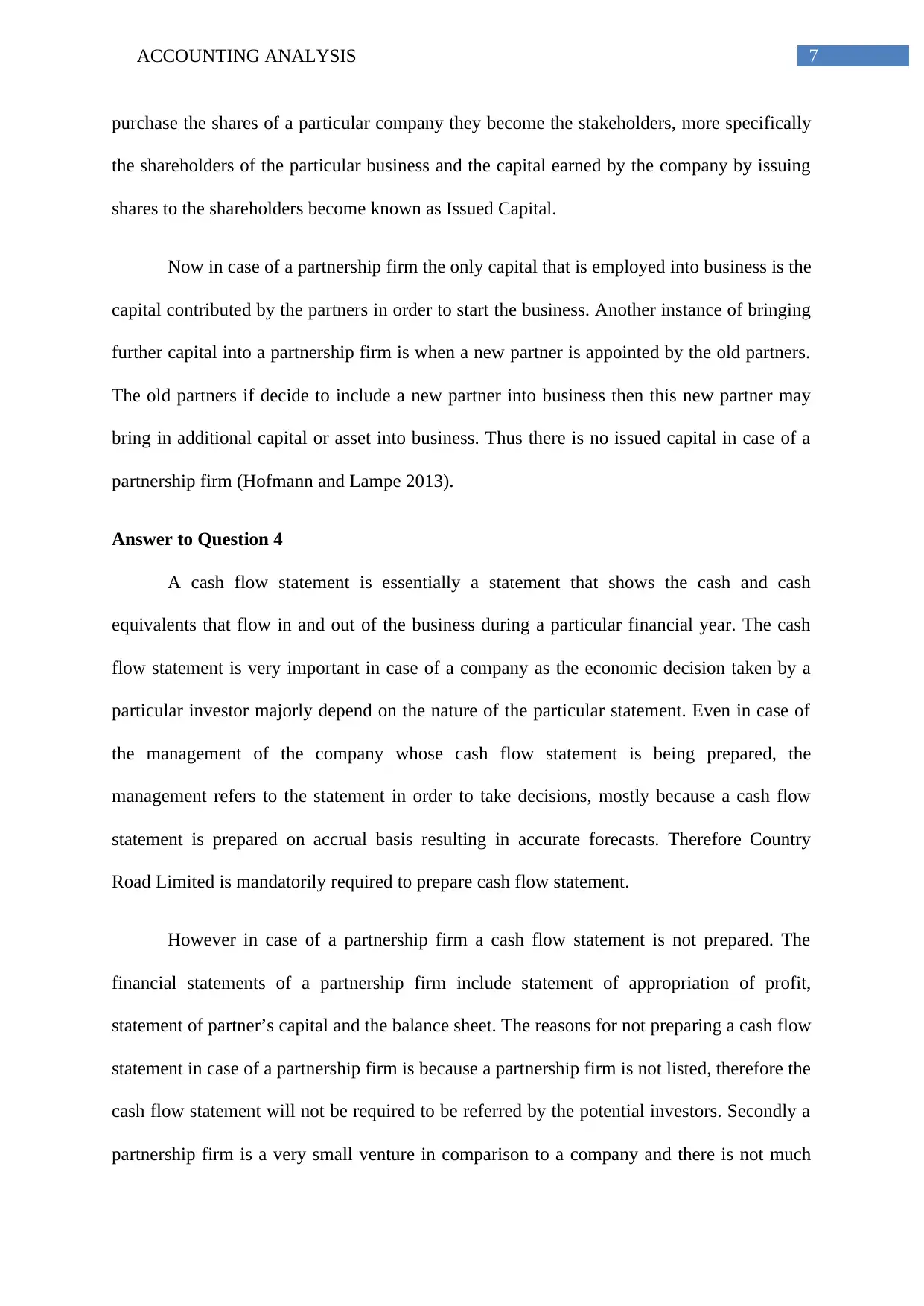
7ACCOUNTING ANALYSIS
purchase the shares of a particular company they become the stakeholders, more specifically
the shareholders of the particular business and the capital earned by the company by issuing
shares to the shareholders become known as Issued Capital.
Now in case of a partnership firm the only capital that is employed into business is the
capital contributed by the partners in order to start the business. Another instance of bringing
further capital into a partnership firm is when a new partner is appointed by the old partners.
The old partners if decide to include a new partner into business then this new partner may
bring in additional capital or asset into business. Thus there is no issued capital in case of a
partnership firm (Hofmann and Lampe 2013).
Answer to Question 4
A cash flow statement is essentially a statement that shows the cash and cash
equivalents that flow in and out of the business during a particular financial year. The cash
flow statement is very important in case of a company as the economic decision taken by a
particular investor majorly depend on the nature of the particular statement. Even in case of
the management of the company whose cash flow statement is being prepared, the
management refers to the statement in order to take decisions, mostly because a cash flow
statement is prepared on accrual basis resulting in accurate forecasts. Therefore Country
Road Limited is mandatorily required to prepare cash flow statement.
However in case of a partnership firm a cash flow statement is not prepared. The
financial statements of a partnership firm include statement of appropriation of profit,
statement of partner’s capital and the balance sheet. The reasons for not preparing a cash flow
statement in case of a partnership firm is because a partnership firm is not listed, therefore the
cash flow statement will not be required to be referred by the potential investors. Secondly a
partnership firm is a very small venture in comparison to a company and there is not much
purchase the shares of a particular company they become the stakeholders, more specifically
the shareholders of the particular business and the capital earned by the company by issuing
shares to the shareholders become known as Issued Capital.
Now in case of a partnership firm the only capital that is employed into business is the
capital contributed by the partners in order to start the business. Another instance of bringing
further capital into a partnership firm is when a new partner is appointed by the old partners.
The old partners if decide to include a new partner into business then this new partner may
bring in additional capital or asset into business. Thus there is no issued capital in case of a
partnership firm (Hofmann and Lampe 2013).
Answer to Question 4
A cash flow statement is essentially a statement that shows the cash and cash
equivalents that flow in and out of the business during a particular financial year. The cash
flow statement is very important in case of a company as the economic decision taken by a
particular investor majorly depend on the nature of the particular statement. Even in case of
the management of the company whose cash flow statement is being prepared, the
management refers to the statement in order to take decisions, mostly because a cash flow
statement is prepared on accrual basis resulting in accurate forecasts. Therefore Country
Road Limited is mandatorily required to prepare cash flow statement.
However in case of a partnership firm a cash flow statement is not prepared. The
financial statements of a partnership firm include statement of appropriation of profit,
statement of partner’s capital and the balance sheet. The reasons for not preparing a cash flow
statement in case of a partnership firm is because a partnership firm is not listed, therefore the
cash flow statement will not be required to be referred by the potential investors. Secondly a
partnership firm is a very small venture in comparison to a company and there is not much
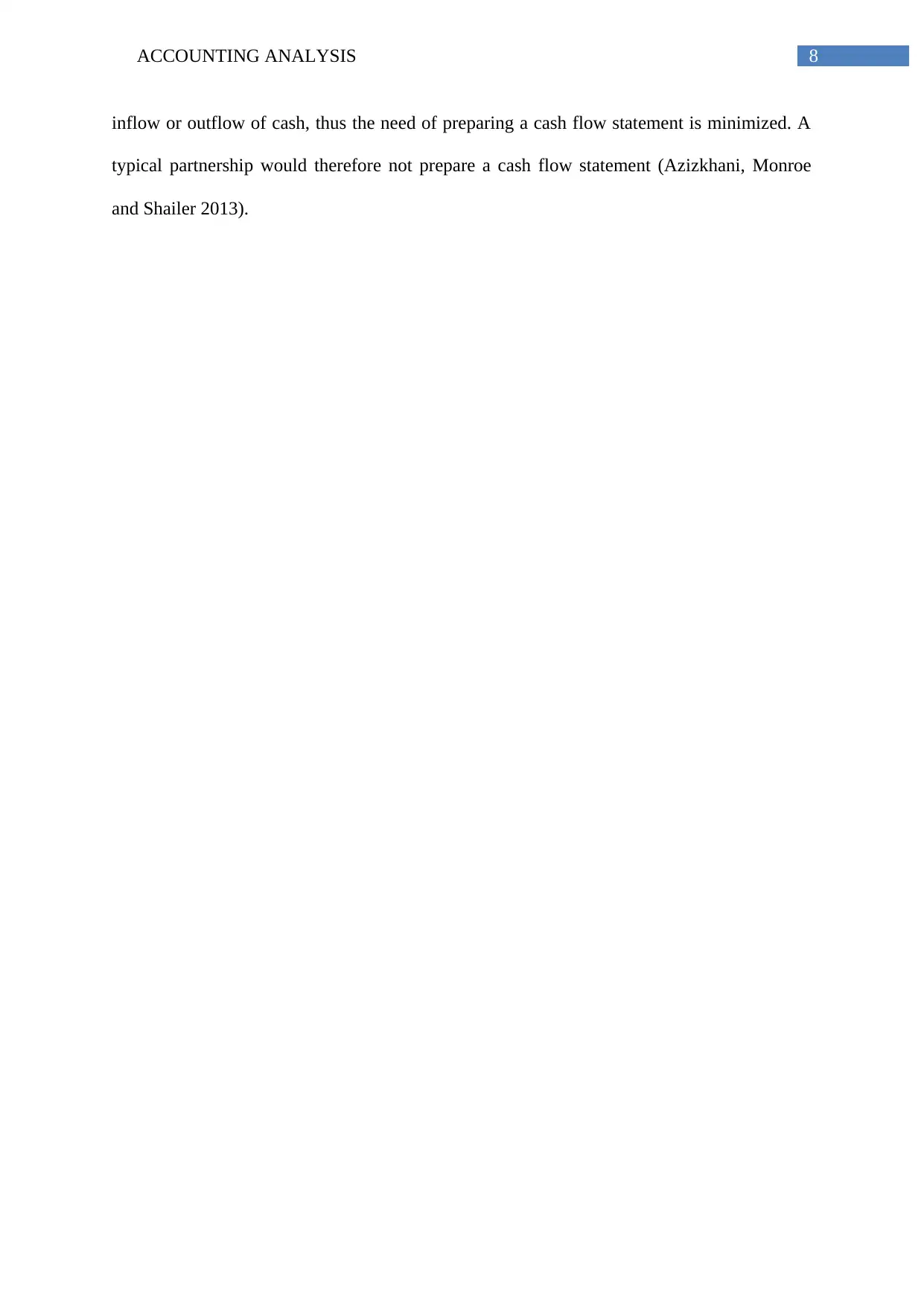
8ACCOUNTING ANALYSIS
inflow or outflow of cash, thus the need of preparing a cash flow statement is minimized. A
typical partnership would therefore not prepare a cash flow statement (Azizkhani, Monroe
and Shailer 2013).
inflow or outflow of cash, thus the need of preparing a cash flow statement is minimized. A
typical partnership would therefore not prepare a cash flow statement (Azizkhani, Monroe
and Shailer 2013).
⊘ This is a preview!⊘
Do you want full access?
Subscribe today to unlock all pages.

Trusted by 1+ million students worldwide
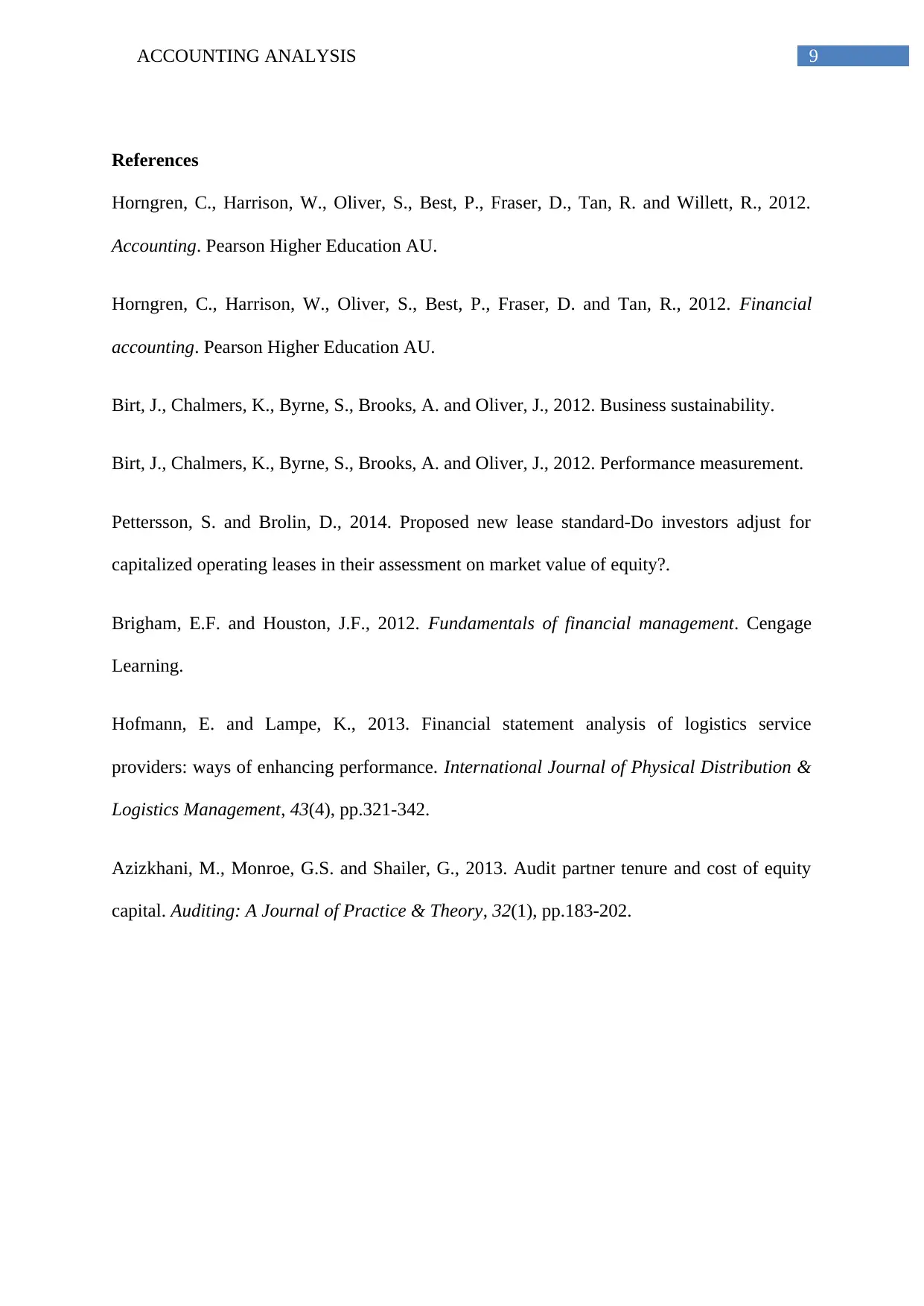
9ACCOUNTING ANALYSIS
References
Horngren, C., Harrison, W., Oliver, S., Best, P., Fraser, D., Tan, R. and Willett, R., 2012.
Accounting. Pearson Higher Education AU.
Horngren, C., Harrison, W., Oliver, S., Best, P., Fraser, D. and Tan, R., 2012. Financial
accounting. Pearson Higher Education AU.
Birt, J., Chalmers, K., Byrne, S., Brooks, A. and Oliver, J., 2012. Business sustainability.
Birt, J., Chalmers, K., Byrne, S., Brooks, A. and Oliver, J., 2012. Performance measurement.
Pettersson, S. and Brolin, D., 2014. Proposed new lease standard-Do investors adjust for
capitalized operating leases in their assessment on market value of equity?.
Brigham, E.F. and Houston, J.F., 2012. Fundamentals of financial management. Cengage
Learning.
Hofmann, E. and Lampe, K., 2013. Financial statement analysis of logistics service
providers: ways of enhancing performance. International Journal of Physical Distribution &
Logistics Management, 43(4), pp.321-342.
Azizkhani, M., Monroe, G.S. and Shailer, G., 2013. Audit partner tenure and cost of equity
capital. Auditing: A Journal of Practice & Theory, 32(1), pp.183-202.
References
Horngren, C., Harrison, W., Oliver, S., Best, P., Fraser, D., Tan, R. and Willett, R., 2012.
Accounting. Pearson Higher Education AU.
Horngren, C., Harrison, W., Oliver, S., Best, P., Fraser, D. and Tan, R., 2012. Financial
accounting. Pearson Higher Education AU.
Birt, J., Chalmers, K., Byrne, S., Brooks, A. and Oliver, J., 2012. Business sustainability.
Birt, J., Chalmers, K., Byrne, S., Brooks, A. and Oliver, J., 2012. Performance measurement.
Pettersson, S. and Brolin, D., 2014. Proposed new lease standard-Do investors adjust for
capitalized operating leases in their assessment on market value of equity?.
Brigham, E.F. and Houston, J.F., 2012. Fundamentals of financial management. Cengage
Learning.
Hofmann, E. and Lampe, K., 2013. Financial statement analysis of logistics service
providers: ways of enhancing performance. International Journal of Physical Distribution &
Logistics Management, 43(4), pp.321-342.
Azizkhani, M., Monroe, G.S. and Shailer, G., 2013. Audit partner tenure and cost of equity
capital. Auditing: A Journal of Practice & Theory, 32(1), pp.183-202.
1 out of 10
Related Documents
Your All-in-One AI-Powered Toolkit for Academic Success.
+13062052269
info@desklib.com
Available 24*7 on WhatsApp / Email
![[object Object]](/_next/static/media/star-bottom.7253800d.svg)
Unlock your academic potential
Copyright © 2020–2025 A2Z Services. All Rights Reserved. Developed and managed by ZUCOL.





